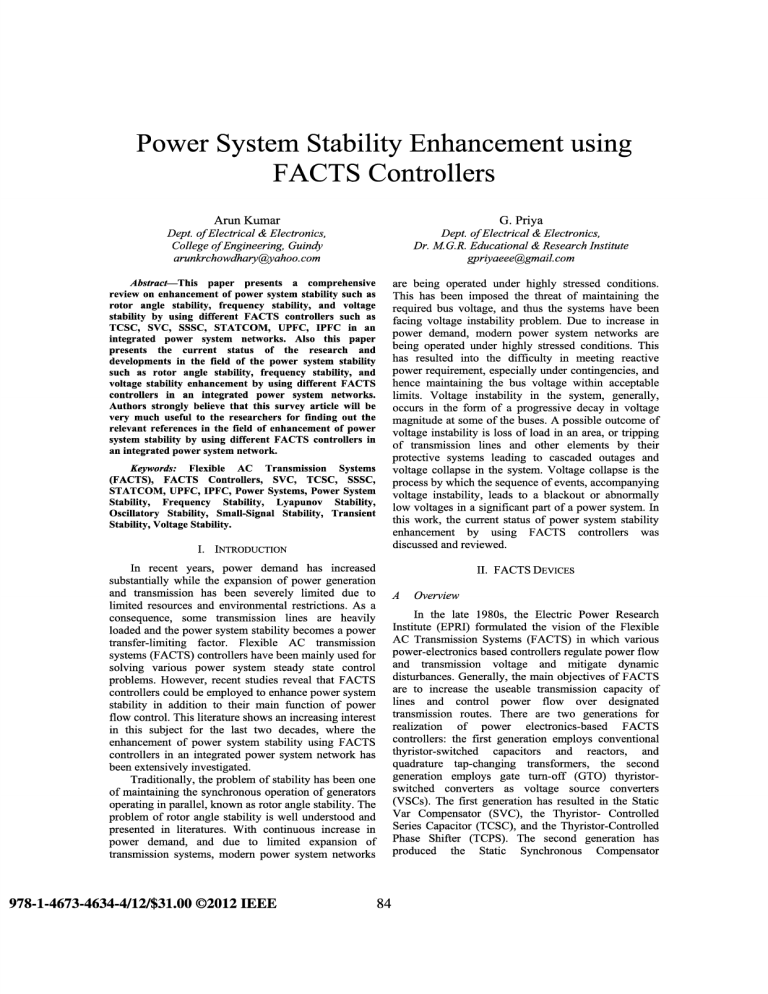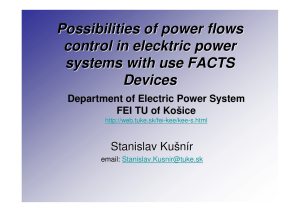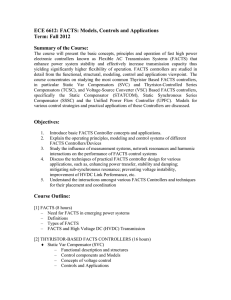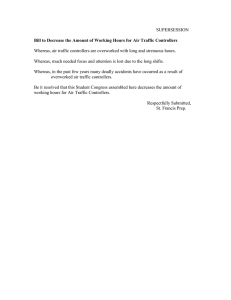
Power System Stability Enhancement using FACTS Controllers ArunKumar G. Priya Dept. ofElectrical & Electronics, College ofEngineering, Guindy arunkrchowdhary@yahoo.com Dept. ofElectrical & Electronics, Dr. M G.R. Educational & Research Institute gpriyaeee@gmail.com are being operated under highly stressed conditions. This has been imposed the threat of maintaining the required bus voltage, and thus the systems have been facing voltage instability problem. Due to increase in power demand, modem power system networks are being operated under highly stressed conditions. This has resulted into the difficulty in meeting reactive power requirement, especially under contingencies, and hence maintaining the bus voltage within acceptable limits. Voltage instability in the system, generally, occurs in the form of a progressive decay in voltage magnitude at some of the buses. A possible outcome of voltage instability is loss of load in an area, or tripping of transmission lines and other elements by their protective systems leading to cascaded outages and voltage collapse in the system. Voltage collapse is the process by which the sequence of events, accompanying voltage instability, leads to a blackout or abnormally low voltages in a significant part of a power system. In this work, the current status of power system stability enhancement by using FACTS controllers was discussed and reviewed. Abstract-This paper presents a comprehensive review on enhancement of power system stability such as rotor angle stability, frequency stability, and voltage stability by using different FACTS controllers such as TCSC, SVC, SSSC, STATCOM, UPFC, IPFC in an integrated power system networks. Also this paper presents the current status of the research and developments in the field of the power system stability such as rotor angle stability, frequency stability, and voltage stability enhancement by using different FACTS controllers in an integrated power system networks. Authors strongly believe that this survey article will be very much useful to the researchers for finding out the relevant references in the field of enhancement of power system stability by using different FACTS controllers in an integrated power system network. Keywords: Flexible AC Transmission Systems (FACTS), FACTS Controllers, SVC, TCSC, SSSC, STATCOM, UPFC, IPFC, Power Systems, Power System Stability, Frequency Stability, Lyapunov Stability, Oscillatory Stability, Small-Signal Stability, Transient Stability, Voltage Stability. I. INTRODUCTION In recent years, power demand has increased substantially while the expansion of power generation and transmission has been severely limited due to limited resources and environmental restrictions. As a consequence, some transmission lines are heavily loaded and the power system stability becomes a power transfer-limiting factor. Flexible AC transmission systems (FACTS) controllers have been mainly used for solving various power system steady state control problems. However, recent studies reveal that FACTS controllers could be employed to enhance power system stability in addition to their main function of power flow control. This literature shows an increasing interest in this subject for the last two decades, where the enhancement of power system stability using FACTS controllers in an integrated power system network has been extensively investigated. Traditionally, the problem of stability has been one of maintaining the synchronous operation of generators operating in parallel, known as rotor angle stability. The problem of rotor angle stability is well understood and presented in literatures. With continuous increase in power demand, and due to limited expansion of transmission systems, modem power system networks 978-1-4673-4634-4/12/$31.00 ©2012 IEEE 84 II. FACTS DEVICES A Overview In the late 1980s, the Electric Power Research Institute (EPRI) formulated the vision of the Flexible AC Transmission Systems (FACTS) in which various power-electronics based controllers regulate power flow and transmission voltage and mitigate dynamic disturbances. Generally, the main objectives of FACTS are to increase the useable transmission capacity of lines and control power flow over designated transmission routes. There are two generations for realization of power electronics-based FACTS controllers: the first generation employs conventional thyristor-switched capacitors and reactors, and quadrature tap-changing transformers, the second generation employs gate tum-off (GTO) thyristorswitched converters as voltage source converters (VSCs). The first generation has resulted in the Static Var Compensator (SVC), the Thyristor- Controlled Series Capacitor (TCSC), and the Thyristor-Controlled Phase Shifter (TCPS). The second generation has produced the Static Synchronous Compensator Power System Stability Enhancement using FACTS Controllers (STATCOM), the Static Synchronous Series Compensator (SSSC), the Unified Power Flow Controller (UPFC), and the Interline Power Flow Controller (IPFC). The two groups of FACTS controllers have distinctly different operating and performance characteristics. be very meaningful. Tan and Wang [78] proposed a direct feedback linearization technique to linearize and decouple the power system model to design the excitation and TCPS controllers. IV. SECOND GENERATION OF FACTS III. FIRST GENERATION OF FACTS A A Static VAR Compensator (SVC) It is known that the SVCs with an auxiliary injection of a suitable signal can considerably improve the dynamic stability performance of a power system [38-61]. In the literature, SVCs have been applied successfully to improve the transient stability of a synchronous machine [38]. Hammad [39] presented a fundamental analysis of the application of SVC for enhancing the power systems stability. B Thyristor-Controlled Series Capacitor (TCSC) Many different techniques have been reported in the literature pertaining to investigating the effect of TCSC on power system stability [62-72]. Several approaches based on modem control theory have been applied to TCSC controller design. Chen et al. [62] presented a state feedback controller for TCSC by using a pole placement technique. However, the controller requires all system states which reduces its applicability. Chang and Chow [63] developed a time optimal control strategy for the TCSC where a performance index of time was minimized. A fuzzy logic controller for a TCSC was proposed in [64]. The impedance of the TCSC was adjusted based on machine rotor angle and the magnitude of the speed deviation. In addition, different control schemes for a TCSC were proposed such as variable structure controller, bilinear generalized predictive controller, and Hoo-based controller. The neural networks have been proposed for TCSC-based stabilizer design. C . Thyristor-Controlled Phase Shifter (TCPS) A considerable attention has been directed to realization of various TCPS schemes [73,74]. However, a relatively little work in TCPS control aspects has been reported in the literature. Baker et al. [75] developed a control algorithm for TCPS using stochastic optimal control theory. Edris [76] proposed a simple control algorithm based on the equal area criterion. Jiang et al. [77] proposed a TCPS control technique based on nonlinear variable structure control theory. In their control scheme the phase shift angle is determined as a nonlinear function of rotor angle and speed. However, in real-life power system with a large number of generators, the rotor angle of a single generator measured with respect to the system reference will not 978-1-4673-4634-4/12/$31.00 ©2012 IEEE 85 Static Compensator (STATCOM) The emergence of FACTS devices and in particular GTO thyristor-based STATCOM has enabled such technology to be proposed as serious competitive alternatives to conventional SVC [79]. From the power system dynamic stability viewpoint, the STATCOM provides better damping characteristics than the SVC as it is able to transiently exchange active power with the system. The effectiveness of the STATCOM to control the power system voltage was presented in [80]. However, the effectiveness of the STATCOM to enhance the angle stability has not been addressed. It was observed that the electromechanical modes are more controllable via phase modulation channel. It was also concluded that the STATCOM-based damping stabilizers extend the critical clearing time and enhance greatly the power system transient stability. B Static Synchronous Series Compensator (SSSC) The SSSC has been applied to different power system studies to improve the system performance [9298]. There has been some work done to utilize the characteristics of the SSSC to enhance power system stability [99; 100]. Wang [99] investigated the damping control function of an SSSC installed in power systems. The linearized model of the SSSC integrated into power systems was established and methods to design the SSSC damping controller were proposed. Kumkratug and Haque [100] demonstrated the capability of the SSSC to control the line flow and to improve the power system stability. A control strategy of an SSSC to enlarge the stability region has been derived using the direct method. The effectiveness of the SSSC to extend the critical clearing time has been confirmed though simulation results on a single machine infinite bus system. C Unified Power Flow Controller (UPFC) A unified power flow controller (UPFC) is the most promising device in the FACTS concept. It has the ability to adjust the three control parameters, i.e. the bus voltage, transmission line reactance, and phase angle between two buses, either simultaneously or independently. A UPFC performs this through the control of the in-phase voltage, quadrature voltage, and shunt compensation. Makombe and Jenkins [101] experimentally proved that a UPFC can control the three control parameters International Conference on Emerging Trends in Electrical Engineering and Energy Management (ICETEEEM-2012) either individually or in appropriate combinations at its series-connected output while maintaining reactive power support at its shunt-connected input. Limyingcharoen et al. [102] investigated the mechanism of the three control methods of a UPFC in enhancing power system damping. It was shown that a significant reduction in the transient swing can be obtained by using a simple proportional feedback of machine rotor angle deviation. V. FACTSINSTALLATIONIssUES For the maximum effectiveness of the controllers, the selection of installing locations and feedback signals of FACTS-based stabilizers must be investigated. On the other hand, the robustness of the stabilizers to the variations of power system operation conditions is equally important factor to be considered. Also, the coordination among different stabilizers is a vital issue to avoid the adverse effects. Additionally, performance comparison is an important factor that helps in selection ofa specific FACTS device. A VLFACTS TECHNOLOGY IMPLEMENTATION AND DEVELOPMENT A Coordination among Different Control Schemes B FACTS Devices Technology Development The technology behind thyristor-based FACTS controllers has been present for several decades and is therefore considered mature. More utilities are likely to adopt this technology in the future as more promising GTO-based FACTS technology is fast emerging. Recent advances in silicon power-switching devices that significantly increase their power ratings will contribute even further to the growth of FACTS technology. A relatively new device called the Insulated Gate Bipolar Transistor (IGBT) has been developed with small gate consumption and small tum-on and tum-off times. The IGBT has bi-directional current carrying capabilities. More effective use of pulse width modulation techniques for control of output magnitude and harmonic distortion can be achieved by increasing the switching frequencies to the low kHz range. However, IGBT has until recently been restricted to voltages and currents in the medium power range. Larger devices are now becoming available with typical ratings on the market being 3.3 kV11.2 kA (Eupec), 4.5 kV/2 kA (Fuji), and 5.2 kV/2 kA (ABB) [185; 186]. The Integrated Gate Commutated thyristor (IGCT) combines the excellent forward characteristics of the thyristor and the switching performance of a bipolar transistor. Performance Comparison The relative efficacy of different FACTS controllers in enhancing of power system stability is investigated [163-167]. The capabilities of PSS, SVCbased stabilizer, TCSC-based stabilizer, and TCPSbased stabilizer to control the electromechanical mode over wide range of operating conditions were discussed in [168] for a weakly connected power system. The results show that the controllability of the electromechanical mode with the TCPS is relatively higher especially at low loading levels and the electromechanical mode is most controllable by TCSC at heavy loading. Similar studies have been carried out for a PSS and different STATCOM and UPFC control channels [81, 169]. Nelson et al. [170] considered four 978-1-4673-4634-4/12/$31.00 ©2012 IEEE FACTS Installations and Utility Experience In the emerging deregulated power systems, FACTS controllers will provide several benefits at existing or enhanced levels of reliability such as balancing the power flow in parallel networks over a wide range of operating conditions, alleviating unwanted loop flow, mitigating interarea power oscillations, and enhancing the power-transfer capacity of existing transmission corridors [171]. Mahran et al. [133] presented a coordinated PSS and SVC controller for a synchronous generator. However, the proposed approach uses recursive least squares identification which reduces its effectiveness for on-line applications. Various approaches for coordinated design of PSS and SVC are also presented in [134-136]. The coordinated design of several TCSCs [137-139], several SVCs [140,141], TCSC and SVC [142-144], HVDC and SVC [145], and PSS and different FACTS stabilizers [146-150] has been discussed. Hiyama et al. [151] presented a coordinated fuzzy logic-based scheme for PSS and switched series capacitor modules to enhance overall power system stability. B FACTS controllers to be evaluated and compared: the SVC, the STATCOM, the TCSC, and the UPFC. The effects of different controllers are expressed in terms of the critical clearing time (CCT). The controller parameters are selected with only consideration of maximizing the CCT. The CCT obtained for the different controllers are compared. Among the shunt controllers, the STATCOM performs better than SVC. The TCSC is more effective than the shunt controllers, as it offers greater controllability of the power flow in the line. The UPFC is by far the best controller, as it provides independent control over the bus voltage and the line real and reactive power flows. 86 Power System Stability Enhancement using FACTS Controllers VII. FACTS ApPLICATIONS TOSTEADY STATE POWER SYSTEM PROBLEMS many new subj ects into power system operation related to trading in a deregulated competitive market. For the sake of completeness of this review, a brief overview of the FACTS devices applications to different steady state power system problems is presented in this section. Specifically, applications of FACTS in optimal power flow and deregulated electricity market will be reviewed. A FACTS Applications to Optimal Power Flow In the last two decades, researchers developed new algorithms for solving the optimal power flow problem incorporating various FACTS devices [194]. Generally in power flow studies, the thyristor-controlled FACTS devices, such as SVC and TCSC, are usually modeled as controllable impedance [14, 24, 36, 195-197]. However, VSC-based FACTS devices, including IPFC and SSSC, shunt devices like STATCOM, and combined devices like UPFC, are more complex and usually modeled as controllable sources [14, 24, 104, 196-200]. Padhy et al. [201] have presented a new hybrid model for OPF incorporating FACTS devices to overcome the classical optimal power flow algorithm where load demands, generation outputs, and cost of generation are treated as fuzzy variables. The optimization objective was chosen to minimize the average loadability on highly loaded transmission lines. The presented power flow control schemes were applied to a voltage-sourced converter-based IPFC, and the resulting control performances were examined using PSCADIEMTDC simulation package. B FACTS Applications to Deregulated Electricity Market In this review, the current status of power system stability enhancement using FACTS controllers was discussed and scrutinized. The essential features of FACTS controllers and their potential to enhance system stability was addressed. The location and feedback signals used for design of FACTS-based damping controllers were discussed. The coordination problem among different control schemes was also considered. Performance comparison of different FACTS controllers has been reviewed. The likely future direction of FACTS technology, especially in restructured power systems, was discussed as well. In addition, utility experience and major real-world installations and semiconductor technology development have been summarized. A brief review of FACTS applications to optimal power flow and deregulated electricity market has been presented. REFERENCES [1] [2] [3] [4] [5] [6] [7] Nowadays, electricity demand is rapidly increasing without major reinforcement projects to enhance power transmission networks. Also, the electricity market is going toward open market and deregulation creating an environment for forces of competition and bargaining. Electricity utilities are in need to serve more loads through their networks and also maintain the system security. FACTS devices can be an alternative to reduce the flows in heavily loaded lines, resulting in an increased loadability, low system loss, improved stability of the network, reduced cost of production, and fulfilled contractual requirements by controlling the power flows in the network. Generally, the changing nature of the electricity supply industry is introducing 978-1-4673-4634-4/12/$31.00 ©2012 IEEE VIII. CONCLUSION [8] [9] Y.N. Yu, Electric Power System Dynamics. Academic Press, 1983. F. deMello and C. Concordia, "Concepts of Synchronous Machine Stability as Affected by Excitation Control", IEEE Trans. PAS, 88(1969), pp.316-329. P.W. Sauer andM.A. Pai,Power System Dynamics and Stability. Prentice Hall, 1998. r.n, Smith, G. Andersson, and C. W. Taylor, "Annotated Bibliography on Power System Stability Controls: 1986-1994", IEEE Trans. on PWRS, 11(2) (1996), pp.794-800. B. Stott, "Power System DYnamic Response Calculations", Proc. IEEE, 67(1979), pp.219-24l. E. Larsen andD. Swann, "Applying Power System Stabilizers", IEEE Trans. PAS, 100(6) (1981), pp.3017-3046. G.T. Tse and S.K. Tso, "Refinement of Conventional PSS Design in Multimachine System by Modal Analysis", IEEE Trans. PWRS, 8(2)(1993), pp.598-605. P. Kundur, Power System Stability and Control. New York: McGraw-Hill, 1993. B.G. Rogers, Power Systems Oscillations. Boston: Kluwer Academic Press, 1999. [10] IEEE Symposium on Eigenanalysis and Frequency Domain Methods for System Dynamic Performance. IEEE Publication No.90TH0292-3-PWR, 1989. [11] IEEE Symposium on Inter-Area Oscillations in Power Systems. IEEE Publication No.95TPI0l, 1994. [12] 1. Paserba, Analysis and Control ofPower System Oscillations. CIGRE Final Report, Task Force 07,Advisory Group 01, Study Committee 38, 1996. [13] A.H.M.A. Rahim and S.G.A. Nassimi, "SYnchronous Generator Damping Enhancement through Coordinated Control of Exciter and SVC", lEE Proc. Genet. Transm. Distrib., 143(2)(1996), pp.211-218. 87




